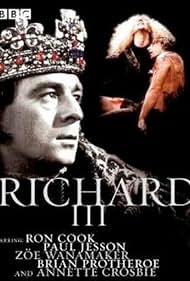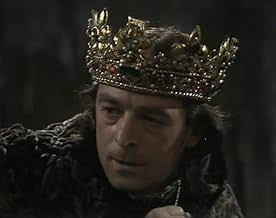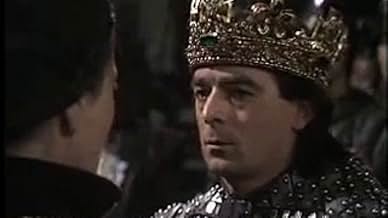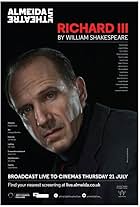CALIFICACIÓN DE IMDb
8.2/10
253
TU CALIFICACIÓN
Agrega una trama en tu idiomaRichard of Gloucester uses murder and manipulation to claim England's throne.Richard of Gloucester uses murder and manipulation to claim England's throne.Richard of Gloucester uses murder and manipulation to claim England's throne.
- Dirección
- Guionista
- Elenco
Antony Brown
- Sir Richard Ratcliffe
- (as Anthony Brown)
- Dirección
- Guionista
- Todo el elenco y el equipo
- Producción, taquilla y más en IMDbPro
Opiniones destacadas
I recently purchased the 4 DVD versions of the BBC TV 1980's 'Henry VI/Richard III' series and they have had me spellbound.
I agree withe the general view of other commentators that the excision of the British 'hammy' style does nothing but enhance the powerful sweep of this epic.
In the final play Ron Cook's deliberately paced and under-stated (by comparison with, say, Olivier) performance renders a powerful image of the 'toad'.
I was especially struck by the scene with the 3 women characters where they debate the evils wrought by their various male relatives on them and their offspring.
The last few scenes covering the night before the battle of Bosworth where the stream of ghosts taunting Richard then support Richmond, highlights what a great piece of pro-Tudor propaganda this play is.
I know that my comments are really about the original Shakespeare play but this production made it live for me.
The final scene with Margaret cackling on top of the heap of dead is a masterstroke!
I agree withe the general view of other commentators that the excision of the British 'hammy' style does nothing but enhance the powerful sweep of this epic.
In the final play Ron Cook's deliberately paced and under-stated (by comparison with, say, Olivier) performance renders a powerful image of the 'toad'.
I was especially struck by the scene with the 3 women characters where they debate the evils wrought by their various male relatives on them and their offspring.
The last few scenes covering the night before the battle of Bosworth where the stream of ghosts taunting Richard then support Richmond, highlights what a great piece of pro-Tudor propaganda this play is.
I know that my comments are really about the original Shakespeare play but this production made it live for me.
The final scene with Margaret cackling on top of the heap of dead is a masterstroke!
It is one of the best known and most produced play by Shakespeare and certainly the best known and most produced history. What's surprising about this play is that it can stand all by itself though knowing the three Henry the Sixth plays help understand the stake of this one. True enough it only helps because this history is very self sufficient, in a way.
We have to clear the plate of a question that is today no longer debated. Shakespeare proposes here the vision of Richard III promoted by the Tudors, that is to say those who vanquished and destroyed him, in order to stabilize and justify their taking over te throne of England. Richard III was not the physical monster they described.
This being said this play is a real thriller. Richard has to eliminate everyone on his path to climb (really climb) to the throne. I would say that sounds plain normal but he declares himself to be evil and to enjoy killing, particularly innocent people. And when he has finally finished the elimination of those who have a blood claim to the throne, except Richmond who has fled to Brittany, he starts killing those who have helped him in his ascent, which is politically absurd and plain suicidal. Henry Tudor, Earl of Richmond, comes back with an army and defeats Richard III at Bosworth in 1485 and thus becomes Henry VII known as the first Tudor king, though he is a Lancaster, which means the House of Lancaster in the end wins but they change the dynastic reference, probably to ensure the past be the past, which might explain why Richard III after proper examination was buried in a small church with no indication on his grave, which explains why in modern times when the church was pull down to open some space for a parking lot no archaeological search was started and Richard III remained under the parking lot for a long time before new excavations to build some new structure finally discovered him, or at least his remains.
The victor is always right and history hates the past and disguises it to the colors of the present, which means the color of the past changes from one present to the next [...]
This production is superb in many ways, once again by the physical acting of pain, sorrow and death, particularly with body language, facial language and tonal language. A triplet of queens is essential: Margaret the old widow of Henry the Sixth; Lady Anne, widow to Edward Prince of Wales, son of Henry the Sixth, later married to the Duke of Gloster who later became Richard the Third; and Elizabeth, queen to Edward the Fourth and then his widow. Of these three queens Lady Anne is the most discreet though fundamental because of her marrying Gloster, the future Richard the Third and the killer of both her husband and her father in law, but another triplet is composed with the Duchess of York, mother to King Edward the Fourth, Clarence and Gloster, the latter to become Richard the Third. The oldest of them, Margaret is a real warmonger against Richard the Third and this production makes her triumphant at the very end, after the concluding words from Henry the Seventh, sitting, laughing hysterically, at the top of a pile of half denuded dead bodies, and holding the corpse of Richard the Third. The full and final step of this purification cycle typical of Shakespeare: she takes, or rather is granted, the victory she is provided with by history or fate [...]
But to show how strong Shakespeare's music can be, I will make a final remark on the famous ghost scene. In his last night living on earth before the battle of Bosworth he has a dream that brings up EIGHT apparitions of ghosts, eleven ghosts all together [...]
EIGHT is the symbol of the Second Coming, and here we have eleven second comings. The Second Coming is the triggering event of the Apocalypse in the Book of Revelation.
ELEVEN is the number of apostles after the elimination of Judas, the eleven apostles who retire away from the Crucifixion (except John) and who deny Jesus, like Peter, and who hide away from the crucifixion and post crucifixion scene out of fear. These eleven apostles announce the resurrection too, even if in a negative way, the way they announce the end of Richard III but they also appear to Richmond and they announce the resurrection of the English monarchy with Henry the Seventh, known as Richmond in this play.
Finally NINE is necessary to complete the prophecy, the prediction, by identifying the beast, in this case Richard the Third. And sure enough the ghosts are going to curse Richard III with a simple formula: "despair and die." And in that ghost scene this mantra is repeated NINE times.
We must understand that in Elizabethan times, after the Reformation and in the ascending phase of chapels and Puritanism, such biblical references (in this case the Passion of Jesus and the Book of Revelation) were unavoidable elements that everyone understood and appreciated. What's more it is very effective in the "propaganda" (rather self-justification) of the Tudors: the killing of the crucifixion is prophesied, the Second Coming is announced and the Beast is identified. We are in the midst of medieval numerical symbolism. This makes me say NINE is the numerical symbol of this king, and as I have already said in my review of Henry the Sixth, Part Three: 1 + 8 = 9; 4 + 5 = 9; 1 + 4 + 8 + 5 = 18 = 9 x 2. The beast is killed on the diabolical date that is also the resurrection date of Bosworth, the final battle. After this last battle the prophecy of the New Messianic Jerusalem becomes possible [...]
Dr Jacques COULARDEAU
We have to clear the plate of a question that is today no longer debated. Shakespeare proposes here the vision of Richard III promoted by the Tudors, that is to say those who vanquished and destroyed him, in order to stabilize and justify their taking over te throne of England. Richard III was not the physical monster they described.
This being said this play is a real thriller. Richard has to eliminate everyone on his path to climb (really climb) to the throne. I would say that sounds plain normal but he declares himself to be evil and to enjoy killing, particularly innocent people. And when he has finally finished the elimination of those who have a blood claim to the throne, except Richmond who has fled to Brittany, he starts killing those who have helped him in his ascent, which is politically absurd and plain suicidal. Henry Tudor, Earl of Richmond, comes back with an army and defeats Richard III at Bosworth in 1485 and thus becomes Henry VII known as the first Tudor king, though he is a Lancaster, which means the House of Lancaster in the end wins but they change the dynastic reference, probably to ensure the past be the past, which might explain why Richard III after proper examination was buried in a small church with no indication on his grave, which explains why in modern times when the church was pull down to open some space for a parking lot no archaeological search was started and Richard III remained under the parking lot for a long time before new excavations to build some new structure finally discovered him, or at least his remains.
The victor is always right and history hates the past and disguises it to the colors of the present, which means the color of the past changes from one present to the next [...]
This production is superb in many ways, once again by the physical acting of pain, sorrow and death, particularly with body language, facial language and tonal language. A triplet of queens is essential: Margaret the old widow of Henry the Sixth; Lady Anne, widow to Edward Prince of Wales, son of Henry the Sixth, later married to the Duke of Gloster who later became Richard the Third; and Elizabeth, queen to Edward the Fourth and then his widow. Of these three queens Lady Anne is the most discreet though fundamental because of her marrying Gloster, the future Richard the Third and the killer of both her husband and her father in law, but another triplet is composed with the Duchess of York, mother to King Edward the Fourth, Clarence and Gloster, the latter to become Richard the Third. The oldest of them, Margaret is a real warmonger against Richard the Third and this production makes her triumphant at the very end, after the concluding words from Henry the Seventh, sitting, laughing hysterically, at the top of a pile of half denuded dead bodies, and holding the corpse of Richard the Third. The full and final step of this purification cycle typical of Shakespeare: she takes, or rather is granted, the victory she is provided with by history or fate [...]
But to show how strong Shakespeare's music can be, I will make a final remark on the famous ghost scene. In his last night living on earth before the battle of Bosworth he has a dream that brings up EIGHT apparitions of ghosts, eleven ghosts all together [...]
EIGHT is the symbol of the Second Coming, and here we have eleven second comings. The Second Coming is the triggering event of the Apocalypse in the Book of Revelation.
ELEVEN is the number of apostles after the elimination of Judas, the eleven apostles who retire away from the Crucifixion (except John) and who deny Jesus, like Peter, and who hide away from the crucifixion and post crucifixion scene out of fear. These eleven apostles announce the resurrection too, even if in a negative way, the way they announce the end of Richard III but they also appear to Richmond and they announce the resurrection of the English monarchy with Henry the Seventh, known as Richmond in this play.
Finally NINE is necessary to complete the prophecy, the prediction, by identifying the beast, in this case Richard the Third. And sure enough the ghosts are going to curse Richard III with a simple formula: "despair and die." And in that ghost scene this mantra is repeated NINE times.
We must understand that in Elizabethan times, after the Reformation and in the ascending phase of chapels and Puritanism, such biblical references (in this case the Passion of Jesus and the Book of Revelation) were unavoidable elements that everyone understood and appreciated. What's more it is very effective in the "propaganda" (rather self-justification) of the Tudors: the killing of the crucifixion is prophesied, the Second Coming is announced and the Beast is identified. We are in the midst of medieval numerical symbolism. This makes me say NINE is the numerical symbol of this king, and as I have already said in my review of Henry the Sixth, Part Three: 1 + 8 = 9; 4 + 5 = 9; 1 + 4 + 8 + 5 = 18 = 9 x 2. The beast is killed on the diabolical date that is also the resurrection date of Bosworth, the final battle. After this last battle the prophecy of the New Messianic Jerusalem becomes possible [...]
Dr Jacques COULARDEAU
As a fan of Richard III, I've seen every version produced. I still do not understand why anyone likes Laurence Olivier's version with its grim, heavy-handed performance. Ron Cook is the perfect Richard, upbeat and energetic, sly and humorous, delighting in his mission until the weight of his crimes begin to trouble his conscience. Jane Powell's direction, as she did with Henry VI parts I, II and III (my favorite of the series), keeps the action moving and the characters in sharp focus, especially King Edward, whose final speech is one you'll always remember. This is the Richard that Shakespeare wanted his audience to see, a man of a courage who loses control of his ambition.
10MarkB-11
I'm fairly sure that many educated and interested-in-film folk have seen the superb and terrifying McKellen version, but sadly, I'd bet hardly anyone remembers this version, which in the original was the capstone of the cycle of plays that begins with Richard II and continues through the various Henry plays (six of 'em). The series was cast as a whole, and the list of actors is a who's-who of British acting skill, culminating in this horrorshow of a play. From the opening moments, when the camera pulls back from the last frame of Henry VI, Part III to reveal a small blackboard, onto which a disembodied hand scrawls Richard III in chalk, to the final frame, where Margaret sits, cackling hysterically atop a pile of bodies (all the characters killed in the preceding eight plays), this version assaults you and tests your ability to withstand true, and intentional villainy, as personified in the demonic Richard. See this version...plague the BBC with letters asking for it to be reissued...write to the actors and shower them with adulation..whatever it takes to return this play to the public eye, where it richardly belongs. Cheers!
In 1982, the BBC, in their undertaking to produce all of Shakespeare's plays, assembled a company of actors which would take us, in one logical arc, from Henry VI part one right through to Richard III. This is notable in that through all four plays, the principal actors keep their roles (although smaller roles are also undertaken). This gives an unparalleled clarity to the events as you see the chaste Margaret descend to Machiavellian plotting to destroy challengers to her grip on power, and then her downfall as Edward and then Richard take power. It is fitting that she, in a horrific scene at the end of this play, is seen atop a mound of dead. This was, after all, her legacy.
In a simple, but effective, set, with authentic costumes and asides taken directly to camera, this brings your closer to Shakespeare's work than much of the praised films and productions in the past.
If you found Olivier's version just too hammy to bear..... try this one.
In a simple, but effective, set, with authentic costumes and asides taken directly to camera, this brings your closer to Shakespeare's work than much of the praised films and productions in the past.
If you found Olivier's version just too hammy to bear..... try this one.
¿Sabías que…?
- TriviaThis episode was filmed on the same set as the three Henry VI plays. However, designer Oliver Bayldon altered the set so it would appear to be a ruin, as England reached its lowest point of chaos. In the same vein, the costumes became more and more monotone as the four plays went on; The First Part of Henry the Sixth (1983) features brightly coloured costumes which clearly distinguish the various combatants from one another, but by this point, everyone fights in similarly coloured dark costumes, with little to differentiate one army from another.
- ErroresWhen Henry VI's corpse is borne in on a brier, the Queen laments the passing of her husband. When she removes the sheets, Henry VI's stomach can clearly be seen heaving.
- ConexionesFeatured in The Story of English: A Muse Of Fire (1986)
Selecciones populares
Inicia sesión para calificar y agrega a la lista de videos para obtener recomendaciones personalizadas
Detalles
Contribuir a esta página
Sugiere una edición o agrega el contenido que falta

Principales brechas de datos
What is the broadcast (satellite or terrestrial TV) release date of The Tragedy of Richard III (1983) in Australia?
Responda




























